BASIL ALKAZZI-
NEW HORIZONS...
BY DONALD KUSPIT
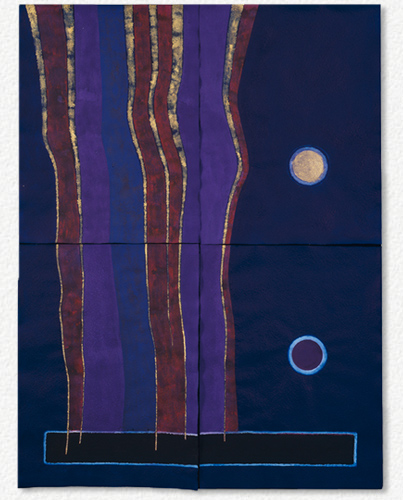
Again and again in the more recent art of Basil Alkazzi we see the same idea, in a cascade of abstract images: the notion of dream repeated like a grand obsession. Thus, we move from a Dream Moment (1993/94) through A Bridge of Dreams (1996) into A Sea of Dreams (1997). He is concerned with a particular kind of dream, as the Sea of Spirit Dreams (1997) indicates. All these works--and there are affiliated works--exist in many variations, each nuancing the original concept of the Spiritual dream. The question, of course, is what does it means to speak of a "Spiritual dream". If a dream is the fantasy fulfilment of an otherwise repressed wish, then the question is what wish is being fulfilled when one dreams of "Spirit". What, exactly, is "Spirit"?
Many of Basil Alkazzi's work, essentially night-scapes, have a similar structure. A number of amoeba-like elements are arranged--often symmetrically, sometimes playfully--on a luminous, atmospheric field of color, usually purple or indigo. This royal surface is often on the verge of darkening. But however opaque, it never loses its inner glow--its inner intensity. The rudimentary bits of organic life tends to exist in relation to some elementary geometrical form, usually a circle, sometimes a square, and sometimes the two superimposed. Like the unmoved mover of ancient philosophy, this eternal geometry is grandly static and centered in contrast to the animated protoplasmic shapes. All these very basic figures seem to float on the sensitive ground like cosmic bodies. Suspended in infinite space, they are all but weightless, and seem preternaturally alive, as the aura that surrounds them implies. It is as though they were imbued with some mysterious energy, making them oddly iridescent. In short, the surface of Basil Alkazzi's images is like an invisible force-field, magnetizing whatever forms exist in it, until they seem strangely sublime.
Dream Moment is a decisive example. A huge black square--related to Malevich's--is suspended in the lower half of a dark crimson field. In the center of the square is a moon in eclipse, surrounded by a pink glow. Corresponding to it in the space beyond and above the square, is a white full moon also surrounded by a pink glow. Sliver-like forms, red and white axes running their length, penetrate the black square and move towards the eclipsed moon. Similar forms rise from the area around the full moon. One has the sense of a dance of life in a spacial night-scape: slivers of primordial life sustain themselves in a cosmos. The opposition between the full moon and the eclipsed moon seems to generate the tense, ambivalent atmosphere of the surface. Dark, with a foreboding of the unknown, it is nonetheless a sufficiently rich soil to sustain elemental life. Opposites are not reconciled in Basil Alkazzi's abstractions, but converge in aparadox that transcends both.
Basil Alkazzi's images are cosmic in import, iconic in character, and profoundly sensual. They render the universal interplay of geometric and organic forms, pared down to pithy, minimilistic clarity. However small and intimate, there is an inner grandeur to Basil Alkazzi's images, which become overt when he links them in an extended--explicitly cosmic- work. At the same time, each image is hermetically sealed, as though to preserve and protect something precious and highly perishable from contamination and spoilage. I want to suggest that what is being preserved and protected is a fugitive sense of life--the amoeba-like life force form symbolizes it--and that what seems a cosmic image is in fact an emotional map.Basil Alkazzi symbolizes inner space--not outer space- -and dramatizes the subtle process of emotional struggle between psychic aliveness and deadness that occurs in it. Above all, he suggests the difficulty of sustaining psychic aliveness in the face of the seemingly overwhelming forces of psychic deadness. The process is conveyed by the demonstration of the simultaneous commensurateness and incommensurateness of crystaline geometric forms and the life symbolizing organic forms. He shows their interaction, even entanglement. Like all mystics, he is aware of the inner continuity of process between apparently discontinuous feelings, particularly the deepest ones--those of psychic aliveness and psychic deadness.
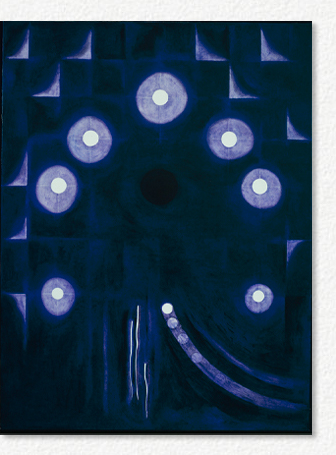
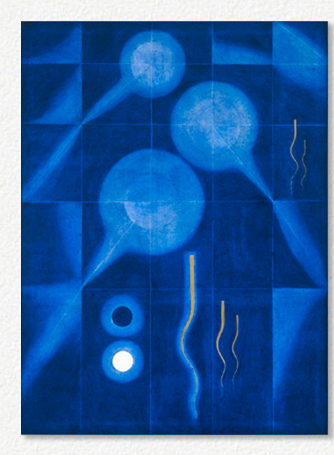
Thus, in the two versions of A Fragrance of Dreams we see full moons and right angles--each encysted in a pale purple aura--systematically arranged on a dark violet and indigo grid. The center of each full moon is at the intersection of one of the horizontals and verticals that form the grid, which is a uniform pattern of modular squares and rectangles. Each right angle also marks an intersection. What is particularly significant is the fact that the right angle is closed off by an aura of curve that could be a reflected glow of one of the moons, suggesting that the reflected glow and hard angle are inwardly connected. Will the serpentine life-force elements that invade the night field catalyze their merger, so that they become indistinguishable and interchangable? Indeed they seem to be the poles of a reversible process of metamorphosis. Basil Alkazzi's image oscillates between the geometrical opposites of curve and angle, and the serpentine life-force elements suggest the energy that compels their interaction, as well as the feeling of life it generates. In a sense, A Fragrance of Dreams, like many of his works, is a transcendental allegory of the relationship between Eros and Thanatos. It is simultaneously a conflict and a marriage. Something new and vital issues from their relationship, suggesting that, for all their differences they are sufficiently intimate to be radically creative.
Indeed, Basil Alkazzi's Transfiguration series seems to show the spontaneous generation of life from the intermixture of forms. The higher realms of a galaxy of pristine moons and the realm of dynamic angles spread over a common field. In their midst a streak of life-force light appears, like a plant miraculously growing in what looks like dark bleak soil. Something similar occurs in the Dream Formation series, wheregroups of organic, colourful life force lines and of geometrical full moons seem positioned like opposing forces, yet slowly but surely they intermingle, and between them something new--the rudiments of astructure--appears, like a welcome mirage. In the two series A Sea of Spirit Dreams and A Sea of Dreams geometrical circle and gestural line unexpectedly combine to form a strange new being. Set on a beautiful mauve sea, it is the ultimate luxury of Spirit.
Basil Alkazzi's art, then, is a sacred, spiritual art, for it unites images of sacred geometry and sacredlife. Abstraction is the best way of invoking the sense of the sacred, if only because it eliminates the appearance of the everyday world. Perhaps nowhere is Basil Alkazzi more clearly sacred and purely abstract than in the gorgeous Ascending Angel: lyric, gold trimmed streams of purple and crimson, conveying the ecstasy of transcendental flight. Transcendental ecstasy is Basil Alkazzi's ultimate subject matter, and he conveys it convincingly through his royal color and geometrical pattern. The earth is left behind, and a new realm of luminous color appears. If the earthly realm is symbolized by the heavy, dark bar that forms the base of the picture, and the sensual dark red moon in its lower half, then heavenly purity is epitomized by the moon of clear gold in its upper half. The passage from dark to light of the Blossoming Moon in Skyscape is another deceptively simple rendering of the movement from living death to spiritual awakening and purity. But the process is reversible--the moon will again turn dark. Like the sea, an ebb and flow.
To return to the question with which I began this essay, what wish is being fulfilled in a Spiritual dream? The wish for inner life--the wish to feel alive on the inside, not just look alive. To dream of the intangible Spirit--to make it tangible in a dream--is to realize what Kandinsky called "inner necessity". It is to experience it as an ecstatic emanation, more particularly, as a spontaneous burst of seemingly living light- -Basil Alkazzi's amoeba-like and life-force form--which suffuses through one's being. His Emanation series articulates this explicitly: it is the light that dwells within the surface, suffusing and shining through all its forms, whether they are geometrical or organic. The surface becomes progressively darker, but the light glows more intensely. The inner light can never be extinguished--that is the message of Basil Alkazzi's Spiritual dream.


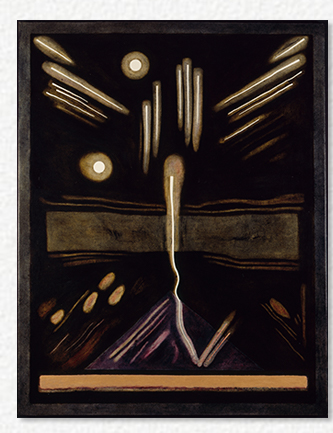
Appendix in the form of a psychological detour to the place of Basil Alkazzi's art in the art of this century. As it draws to a close, it is necessary to ask oneselfwhat the purpose of art has been in it. It has been justly celebrated as a century of formal innovation- -a century which expanded the possibilities of art making,until art made of any kind of material and in any manner became acceptable. At the same time, art has come into question during the century, until no one is sure exactly what it is. Many artists themselves have excelled at this destructive self questioning, which sometimes passes as ironical wit, sometimes as tongue-in-cheek attack against the spectator. So-called conceptual art, which separates the idea of art from the making of art, is the most serious manifestation of this epistemological game. But all of this has to do with life within the stormy hothouse of art, not with the human use of art in the life world beyond it.There one question looms large: what has art done for humanity?
In asking this question, I am aware of what science and technology have done for humanity. A special issue of Newsweek documents "The Power of Invention," more particularly, "How an explosion of discoveries changed our lives in the 20th century." How has twentieth century art changed our lives for the better? That is the question that has subliminally informed my discussion of Basil Alkazzi's art, which offers one answer--an answer that places it in what for me is the grandest tradition of twentieth century art. His art, like that of Kandinsky and Rothko, keeps alive a sense of spirituality in a century that, however materially glorious, has been spiritually bankrupt, with devastating emotional consequences for its inhabitants. Like their art, Basil Alkazzi's art is concerned with what Kandinsky in Concerning The Spiritual Art called "the all important spark of inner life"--in the modern world "only a spark." It is implicit in the "inner meanings" or "spiritual vibrations" of colours, which seem to havea life of their own Like Kandinsky's and Rothko's subtle art of color, that of Basil Alkazzi "endeavours to awake the subtler emotions, as yet unnamed," than those that occur in the course of everyday life--emotions that sparkle with, and seem a source of, inner life.
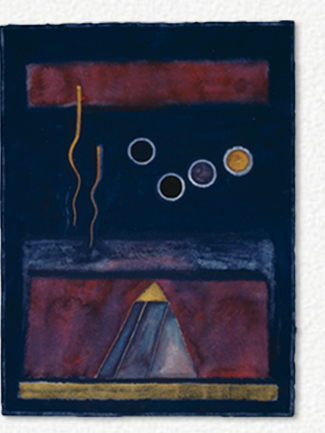
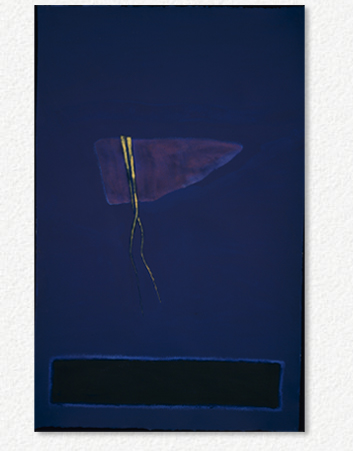
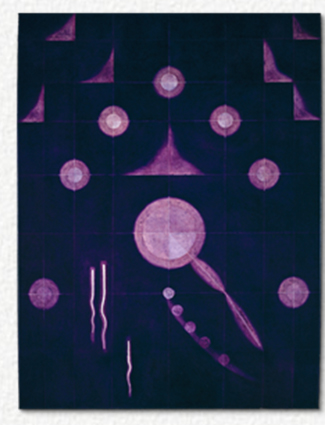
To nourish and sustain a sense of spirituality is to keep oneself alive inwardly- -to feel inwardly significant,and to experience a sense of inner purpose- -in a world that, for all its scientific and technological triumphs has, however unwittingly, promoted a sense of inner deadness and with it the insignificance and purposelessness of human life. I believe that the sense of psychic deadness is, on one level an extravagant form of intellectualization, absolute and complete enough to deny recognition of the self that carries out these experiments, conceives these theories, and makes these inventions. I also believe psychic deadness is an inevitable consequence of the collapse of transcendental myths--myths that suggest a higher consciousness and deeper experience of life than is available through everyday consciousness and deeper experience. These myths have been deconstructed into language, which is to miss their emotional point. Popular culture masks this unconscious sense of psychic deadness with a veneer of pseudo-vitality--by creating an illusion of inexhaustible energy, which is supposedly able to save us from our spiritless selves. But it has become increasingly clear that, however pervasive and persuasive it is- however much it has shaped collective consciousness- -it is a spiritual failure. Indeed, it ridicules spiritual aspiration, because it is unequal to it.
I think Basil Alkazzi's art speaks to all these issues. It repudiates popular culture imagery, conveys a sense of intimacy, fuses sensual effect with intellectual structure, and has transcendental import. In all this- and in appearance--Basil Alkazzi's art seems to be informed by Rudolph Steiner's ideas, however much its nuanced atmosphere resembles that of Rothko's paintings, and its subtle tensions resemble those in Kandinsky's geometric paintings. Steiner's ultimate interest was in the astral body, which shone through the physical body. It is the astral body that Basil Alkazzi renders, in as dematerialized a form as possible. Every detail of his art--his geometrical and organic figures as well as the ground on which they are inscribed--is pervaded by what might be called an astral effect. I have used the conventional term "innerlight" to describe it, but that reifies what Jorge Luis Borges, in his account of the visionary character of Steiner's thought, calls "radiating energy." It is manifest through "energy objects." This energy, known only by its "sparkle and shine", is evident in Basil Alkazzi's energy objects, whether geometric or organic. To keep alive the sense of Spiritual energy that gives one life, as Basil Alkazzi's visionary art does, is no mean feat. It is a humane feat, for our century regards matter and energy as interchangeable, as though human beings at their most vital were not driven by Spiritual energy.
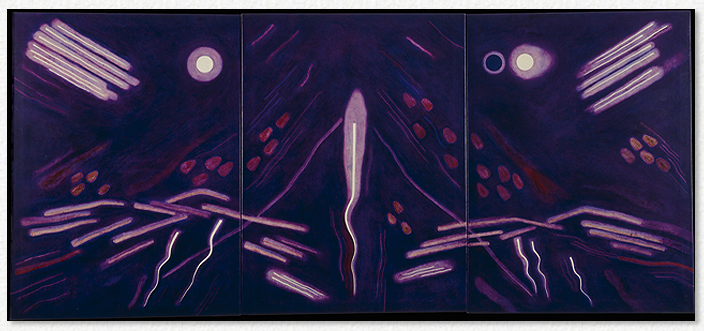
Full text copyright 1998 by Donald Kuspit and K.IZUMI Art Publications Ltd.
Full text copyright 1998 by Basil Alkazzi and K.IZUMI Art Publications Ltd.
All rights reserved under International and Pan-American copyright conventions.